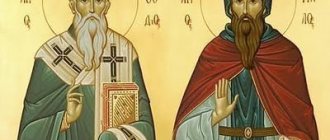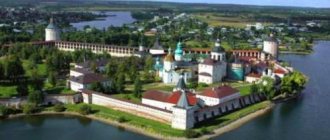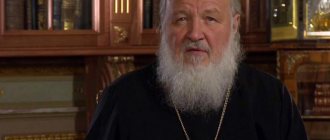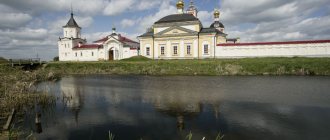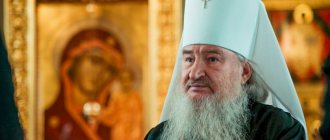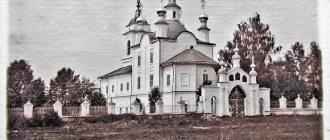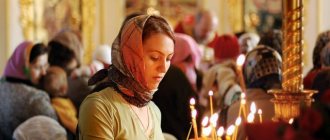| St. Kirill Belozersky, 16th century icon |
Kirill Belozersky
(+ 1427), abbot, venerable Commemoration on June 9, in the Cathedral of Moscow and in the Cathedral of Radonezh Saints
In the world, Cosma was born in Moscow to pious parents. In his youth, he was left an orphan and lived with his relative, boyar Timofey Vasilyevich Velyaminov, a circus at the court of Grand Duke Dimitri Donskoy.
Social life weighed heavily on the young man. At the request of the Monk Stefan of Makhrishchi (+ 1406), the boyar released Cosmas to the Simonov Monastery, where he took monastic vows from St. Theodore with the name Cyril.
The Monk Kirill performed his monastic obediences under the guidance of Elder Michael, later Bishop of Smolensk. At night, the elder read the Psalter, and St. Cyril bowed, but at the first strike of the bell he went to Matins. He asked the elder for permission to eat food after 2-3 days, but the experienced mentor did not allow this, but blessed him to eat every day with the brethren, but not to the point of satiety. The Monk Kirill carried out obedience in the bakery: he carried water, chopped wood, and distributed bread. When the Monk Sergius of Radonezh came to the Simonov monastery, he, first of all, visited and talked with love with the Monk Kirill. From the bakery, the Monk Cyril was transferred to the kitchen, and the saint said to himself, looking at the blazing fire: “See, Cyril, that you don’t end up in the eternal flame.” The Monk Kirill worked in the kitchen for nine years and acquired such tenderness that he could not eat bread without tears, thanking the Lord.
Avoiding human glory, the monk at times began to act like a fool. As punishment for violating decorum, the abbot prescribed bread and water as food for 40 days; St. Cyril joyfully bore this punishment. But no matter how much the saint hid his spirituality, the experienced elders understood him and against his will forced him to accept the rank of hieromonk. In his free time from serving, the Monk Kirill placed himself in the ranks of a novice and did hard work. When Saint Theodore was consecrated Archbishop of Rostov, the brethren in 1390 elected Saint Cyril as archimandrite of the monastery.
Rich and noble people began to visit the monk to listen to his instructions. This confused the saint’s humble spirit, and no matter how much the brethren begged him, he did not remain abbot, but secluded himself in his former cell. But here, too, frequent visitors disturbed the monk, and he moved to the old Simonovo. The soul of St. Cyril strove for silence, and he prayed to the Mother of God to show him a place useful for salvation. One night, while reading, as always, an akathist before the icon of the Mother of God Hodegetria, he heard a voice: “Go to Beloozero, there is a place for you.”
In the Beloezerskaya side, then remote and sparsely populated, he walked for a long time in search of the place that in the vision was intended for his stay. In the vicinity of Mount Myaury near Lake Siverskoye, he, together with his companion the Monk Ferapont, erected a cross and dug a dugout.
The Monk Ferapont soon retired to another place, and the Monk Cyril labored alone for many years in an underground cell. One day Saint Cyril, tormented by a strange dream, lay down to sleep under a pine tree, but as soon as he closed his eyes, he heard a voice: “Run, Cyril!” Only the Monk Kirill had time to jump away when the pine tree collapsed. The ascetic made a cross from this pine tree. Another time, the Monk Kirill almost died from flames and smoke when he was clearing the forest, but God protected His saint. One peasant tried to set fire to the monk’s cell, but no matter how hard he tried, he failed. Then, with tears of repentance, he confessed his sin to the Monk Cyril, who tonsured him into monasticism.
From the Simon's monastery the monks Zebedee and Dionysius, whom he loved, came to the monk, and then Nathanael, later the cellarer of the monastery. Many began to come to the monk and ask to be honored with monasticism. The holy elder realized that his time of silence was over. In 1397, he built a temple in honor of the Dormition of the Blessed Virgin Mary. This is how the Kirillo-Belozersky Monastery was founded.
When the number of brethren increased, the monk gave the monastery a community charter, which he illuminated with the example of his life. No one dared to talk in the church, no one was supposed to leave it before the end of the service; the Holy Gospel was approached according to seniority. Everyone sat down at their own place for the meal, and there was silence in the refectory. From the refectory everyone walked silently to his cell. No one could receive letters or gifts without showing them to St. Cyril; No letters were written without his blessing. The money was kept in the monastery treasury; no one had any property. They even went to the refectory to drink water. The cells were not locked, and they contained nothing except icons and books. In the last years of the life of the Monk Kirill, boyar Roman decided to donate the village to the monastery and sent a deed of gift. The Monk Kirill reasoned that if the monastery began to have villages, then the brethren would begin to worry about the land, settlers would appear, the monastic silence would be broken, and he refused the gift.
The Lord rewarded His saint with the gift of insight and healing. A certain Theodore, having entered the monastery out of love for the monk, then hated him so much that he could not look at the saint and tried to leave the monastery. He came to the cell of St. Cyril and, looking at his gray hair, could not utter a word out of shame. The monk told him: “Do not grieve, my brother, everyone is mistaken about me, you alone know the truth and all my unworthiness; I am truly an obscene sinner.” Then the Monk Cyril blessed Theodore and added that he would no longer be troubled by his thoughts; From then on, Theodore lived quietly in the monastery.
One day there was not enough wine for the Divine Liturgy, and the sexton told the saint about this. The Monk Kirill ordered an empty vessel to be brought to him, which turned out to be full of wine. During the famine, St. Cyril distributed bread to everyone in need, and it did not run out, despite the fact that usually the supplies were barely enough for the brethren.
The monk tamed the storm on the lake, which threatened the fishermen, predicted that none of the brethren would die before his death, despite the fact that the pestilence was raging, and after that many would follow him.
The monk performed his last service on the day of the Holy Trinity. Having bequeathed to the brethren to preserve love among themselves, the Monk Cyril rested blissfully in the 90th year of his life on June 9, 1427. In the very first year after the death of the monk, 30 of the 53 brethren died. To those who remained, the monk often appeared in dreams with support and guidance.
Reverend Kirill loved spiritual enlightenment and instilled this love in his students. According to the inventory of 1635, there were more than 2 thousand books in the monastery, among them 16 of “the wonderworker Cyril.” Remarkable examples of spiritual mentoring and guidance, love, peacefulness and consolation are the three letters of the saint to the Russian princes that have come down to us.
All-Russian veneration of the saint began no later than 1447-1448. The Life of St. Cyril was written on behalf of Metropolitan Theodosius and Grand Duke Vasily Vasilyevich by Hieromonk Pachomius Logofet, who arrived at the Kirillo-Belozersky Monastery in 1462 and found many eyewitnesses and disciples of St. Cyril, including St. Martinian, who then ruled the Ferapontov Monastery.
Venerable Kirill Belozersky: holy hermit from the lake
Through trials - to serving God
Reading the biographies of various saints, we can notice that their path to the ascetic life was by no means rosy, but filled with many trials.
It is extremely rare for things to be different. The same fate befell Cosmas, the future Venerable Kirill of Belozersky. Having lost his parents early, young Kosma got a job as a butler for the noble boyar Timofey Velyaminov. Then he had a desire to take monastic vows. But, not wanting the diligent servant to leave the boyar estate, his boss did his best to prevent the young man from leaving for the monastery. Velyaminov’s high social position did not allow even authoritative confessors to persuade him to release the young man from a secular position, which he was very burdened with.
The only one who risked carrying out a risky scam was the Monk Stefan Makhritsky, who was in authority with the intractable boyar. The priest decided on a kind of provocation: he dressed Kosma in monastic robes, ordered him to be called Kirill, and blessed him to appear in this guise before the eyes of the landowner. The idea was this: if the boyar came to terms with the new status of his treasurer, then Stefan would take real tonsure on Kosma, and if he got angry, he would simply remove his imaginary monastic vestments. As a result, both happened. The landowner was at first seriously angry with Stefan for his arbitrariness, and then, at the instigation of his pious wife, he released the butler in peace to the monastery.
Velyaminov’s high social position did not allow even authoritative confessors to persuade him to release the young man from a secular position, which he was very burdened with. The only one who risked carrying out a risky scam was the Monk Stefan Makhritsky, who was in authority with the intractable boyar.
Having entered the Simonov Monastery already at a fairly mature age, Kirill was given by the abbot to the spiritual leadership of the monk Mikhail, the future bishop of Smolensk. Serving as his cell attendant, the new monk spent his nights on kneeling prayers, and his days in obediences and church services. Despite the great physical exertion, he was so zealous in his exploits that his confessor had to stop his spiritual zeal.
The demons also wanted to lead Cyril astray from the right path, painting terrible pictures in his imagination and frightening him during prayers. Only by calling on the Name of God for help was he able to courageously repel these attacks. Spiritual warfare hardened the ascetic. One of the researchers of his life, academician E. Golubinsky, wrote about this stage of his monastic life: “He constantly behaved as if at all times he was trying not to have his own will at all, but only reckless obedience.”
The Monk Sergius of Radonezh, who visited Simon’s monastery, also drew attention to the ascetic. Coming to the cookhouse, he talked with him, instructing him in spiritual truths.
Escape from popularity and miraculous salvation
Icon “St. Kirill of Belozersky with 21 marks of life.”
Dionisy's workshop. Beginning of the 16th century. Photo: kirillbelozersky.ru In the 14th century, as now, experienced confessors endured the temptation of human glory. When Monk Kirill became a priest, he gravitated towards silence and a more attentive spiritual life. At the beginning of his monasticism, the abbot of the monastery saw in him his successor, but the monk, who strived for hermitage, was able to escape administrative obedience.
However, the temptations in the monastery did not stop there. Clouds began to gather over Kirill when the newly appointed archimandrite of the monastery saw in him a competitor who attracted more attention from the parishioners. The monk had no choice but to pray to the Mother of God to help him resolve the growing problem. After much prayer, he received instructions from the Queen of Heaven to leave the monastery and direct his steps to the Belozersky region. The saint was very happy about this blessing. Belozerye had long attracted him with its remoteness from the bustle of the world. Taking with him his fellow monk Feropont, he set off into the future unknown, completely relying on the will of God.
Clouds began to gather over Kirill when the newly appointed archimandrite of the monastery saw in him a competitor who attracted more attention from the parishioners. The monk had no choice but to pray to the Mother of God to help him resolve the growing problem.
To assure the ascetic of the correctness of his choice, the Lord miraculously saved his life after, having reached Belozerye, Cyril and Ferapont parted in order to further asceticize each one alone.
One day, having dug a dugout in the forest, the ascetic dozed off among the majestic pines. Suddenly, out of nowhere, he heard a loud shout: “Run, Kirill!” He immediately woke up and immediately jumped to the side. A moment later, a pine tree fell noisily on the place of his recent rest. Having glorified God for deliverance from a premature death, the monk sawed out a cross from a fallen pine tree.
But the saving right hand of Christ did not stop protecting the ascetic from troubles. When he settled in a makeshift wooden cell, a local peasant turned against him and wanted to set fire to the dilapidated hut. But all the arson attacks were unsuccessful. Realizing his sin, the criminal repented and brought his confession to St. Cyril. After this, the former sinner became the companion of the holy confessor on the monastic path.
From hatred to love - one step
View of the Kirillo-Belozersky Monastery.
Photo: wikipedia.org Rumors about the holy ascetic quickly spread throughout the area, and not only those seeking advice or healing, but also those desiring monastic feats began to flock to Lake Siverskoye. A monastery, now known as Kirillo-Belozersky, began to grow around the saint’s cell. Seeing the ardent desire of people to share with him the hardships of monastic life, Saint Kirill of Belozersky arranged the way of monastic life, establishing a strict charter. Demanding his fulfillment from the brethren, he himself impeccably fulfilled every instruction he drew up.
The monk never wanted to be the cause of discord among the brethren and to cause anyone embarrassment with his behavior. His foresight protected the monks not only from spiritual decline, but also from unjustifiably leaving the monastery.
The saint showed that from hatred to love there is only one step, but for this you need to be the first to admit your imperfection.
There was a case when one brother, through devilish temptation, hated the saint so much that he decided to leave the monastery forever. Entering the cell of St. Cyril, he was already ready to pour a tub of verbal impurities on his confessor. But the saint only looked at him in a fatherly way and said: “Don’t grieve, everyone is mistaken about me, you alone know the truth and all my unworthiness; I am truly an obscene sinner.” After this, the sinful thoughts no longer tormented the monk, and he safely continued his life in Belozerye. The saint showed that from hatred to love there is only one step, but for this you need to be the first to admit your imperfection.
Saint Cyril performed many other miracles. Like Christ, in the absence of wine at the Liturgy, he transformed water into wine, during a famine he fed the brethren with endless supplies of bread and tamed the storm on the lake. When a pestilence broke out around the monastery, the saint assured the monks that he would be the first to repose before God, and the brethren would follow him into eternity. And so it happened: after the death of St. Kirill of Belozersky, out of 53 inhabitants of the monastery, 30 people died.
* * *
The holy ascetic left behind not only memories of miracles, but also valuable spiritual edifications, reflected in his messages to the Russian princes. Each of his letters is filled with humility and self-reproach.
“I, a sinner, grieve my soul more that you please me, unworthy and resigned to every sin, having not acquired a single virtue, but guilty of every passion,” he wrote to representatives of secular authorities in response to laudatory speeches addressed to him. At the same time, he did not please those in power, but warned them about responsibility for their every action before God.
How often do we lack such holiness in humility. It seems to us that to be a saint is necessarily to be an ascetic and an ascetic. But in fact, only those who humble their souls before the Lord and other people achieve holiness, who, according to the commandment of Christ, receive primacy, becoming a servant for everyone.
Let us pray to St. Kirill of Belozersky that he will help us find true humility and learn to always thank the All-Merciful God for everything!
Prayers
Troparion, tone 1
As thou didst flourish in the desert of David, Father Cyril, / uprooting the thorns of evil, / and thou didst gather in it a multitude of disciples, / taught by the fear of God and thy teaching, / whom thou didst not abandon to the end, like a child-loving father, / visiting, and all crying out : / glory to Him who gave you strength, / glory to Him who crowned you, / glory to Him who heals you all.
Kontakion, tone 8
As having overcome corruption and the valley that attracts wisdom, Father, / you joyfully rushed to the High Current, / and there you stand with the saints of the Most Holy Trinity, / pray that your flock will be preserved from the enemy, / as we celebrate your holy Dormition, crying out: Rejoice, most blessed Kirill, our father.
Iconography
According to monastic tradition, the first icon of St. Cyril was painted during his lifetime. It was created by Dionysius Glushitsky. The researchers who carried out the restoration of the relic attributed it to the Novgorod school. The peculiar simplicity of the composition and writing technique was also noted.
The saint is depicted on hagiographic icons or against the background of the monastery he founded. Invariably the canonical spelling of the reverend himself. He is depicted as a handsome old man in a dark monastic robe. Often in his hands is a scroll with a dying lesson for the flock. The face of the saint with his characteristic facial expressions radiates calm. A penetrating, wise gaze is directed at the viewer.
It is believed that prayer in front of the image of the righteous father helps to strengthen one’s faith, conscientiously perform one’s work duties, and avoid idle temptations. Of course, the saint’s special protection extends to people who bear his name.
Literature[ | ]
- Golubinsky E. E.
Reverend Kirill Belozersky. - Kontsevich I.M.
Acquisition of the Holy Spirit in the ways of Ancient Russia. - Melnik A. G.
Kirillo-Belozersky Monastery as a center of veneration of Russian saints in the 16th century // Vest. Pomeranian University. Series “Humanities and Social Sciences”. - 2010. - Issue. 12. - pp. 67-72. - Melnik A. G.
Visual representation of the cult of St. Cyril of Belozersky in the monastery he founded in the 15th - early 17th centuries. // TODRL. - St. Petersburg; Rostock, 2021. - T. 64. - P. 365-374. — ISBN 978-5-94668-205-3. - Melnik A. G.
History of the spread of the cult of St. Kirill Belozersky in Rus' in the XV-XVI centuries. // TODRL. - St. Petersburg; Rostock, 2021. - T. 65. - P. 301-310. — ISBN 978-5-94668-226-8. - Reverends Kirill, Ferapont and Martinian of Belozersky. - St. Petersburg, 1994.
- Prokhorov G. M.
Kirill Belozersky // Dictionary of scribes and bookishness of Ancient Russia. — Vol. 2. Second half of the XIV-XVI centuries. - Part 1. A-K. - M.: Nauka, 1988. - Prokhorov G.M.
Books by Kirill Belozersky // Tr. dept. other-russian lit. - T. XXXVI. - M.-L., 1981. - P. 50-70.
Veneration in Orthodoxy
Since the authority of the monk was undeniable, his veneration began during his lifetime. Although official canonization occurred only in 1547, the first life, which was a model of monastic service for many ascetics, was compiled long before that, by Pachomius Logothetes.
Kirill Belozersky is one of the revered saints in a number of cathedrals: Kostroma, Vologda and Novgorod, Radonezh. In accordance with this, his memory is celebrated several times a year: February 5, June 9, July 11, July 19. On these solemn days, Orthodox Christians remember and glorify the spiritual feat of the saint.
